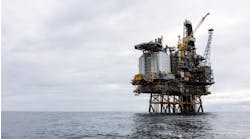Project sanctioning to exceed pre-COVID-19 levels from 2022, analyst claims
Offshore staff
OSLO, Norway – The COVID-19 pandemic has devastated global oil and gas project sanctioning this year and will cause total committed spending to drop to around $53 billion from 2019’s $190 billion, according to Rystad Energy. Postponed plans will, however, cause the total worth of final investment decisions (FIDs) to double next year and exceed pre-pandemic levels from 2022.
Offshore commitments are now expected to reach $34 billion in 2020, down from 2019’s $101 billion. Onshore sanctioning is likely to fall to $19 billion this year from $89 billion last year.
The consultant estimates total sanctioning to bounce back to around $100 billion in 2021, primarily supported by offshore projects, whose value is forecasted at $64 billion for the year. Although lagging onshore projects are projected to only account for $36 billion in 2021, they will see a steep rise in 2022 to around $100 billion, topping the expected $95 billion worth of offshore commitments that year.
The consultant has also revised up its 2020 offshore sanctioning total from $26 billion to $34 billion. This was driven by the Mero-3 sanctioning in Brazil, which is estimated to cost $2.5 billion to first oil. MISC has a letter of intent in place with Petrobras for the charter of the FPSO. The contractor will sub-contract the vessel construction work to Chinese yards, with China Merchants Heavy Industry leading the race to build both the hull and topsides. Siemens will deliver the power generation modules, while Aker Solutions is performing front-end engineering and design and engineering work on the FPSO topsides.
The consultant also expects commitments worth $3.6 billion related to the Payara development off Guyana in 2020. SBM Offshore is operating under an advanced commitment on the FPSO with ExxonMobil and its partners and the contractor has started procurement activities in collaboration with Chinese and Singaporean yards. Shanghai Waigaoqiao Shipbuilding is responsible for supplying the hull for the FPSO and the topsides will be built by Dyna-Mac and Keppel. It is now only a matter of when the FID takes place, and Rystad expects it to happen soon.
Before the oil price crash, Shell had awarded a major contract to Sembcorp Marine for construction of the topsides and hull of a floating production unit for the Whale project in the US Gulf of Mexico. Now uncertain economic conditions have forced Shell to defer FID for the project to 2021. Whale has a breakeven of more than $40/bbl. As the second wave of COVID-19 surges through Europe, America and South Asia, it is uncertain whether the new development will start anytime soon, as the social distance norms and quarantine requirements will not only hamper the pace of development but could also lead to cost overruns, the consultant claimed.
Recently, the Norwegian Ministry of Petroleum and Energy approved the plan for development and operation (PDO) of the Balder Future project. The partners, Vår Energi and Mime Petroleum, submitted a revised PDO last December and selected their preferred contractors in 2019. The $2-billion development plan includes an upgrade of the Jotun FPSO vessel which will operate between the Balder and Ringhorne fields. The FPSO is being upgraded by Worley, while Baker Hughes and Ocean Installer are responsible for supplying the subsea facilities.
Lastly, China Offshore Oil Engineering Co. confirmed the start of development activities on CNOOC’s Luda 6-2 oilfield off China in its 2Q results. The Luda 6-2 development will entail a central processing platform and is estimated to cost nearly $170 million in greenfield commitments. Production is likely to start in early 2022.
09/21/2020



